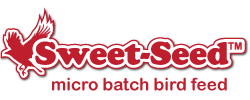Will Orioles Drink Out of Hummingbird Feeders?

Hummingbirds aren’t the only birds with a sweet tooth for sugary nectar, and birders who feed hummingbirds may also find nectar-loving orioles at their feeders. But do orioles really need their own special feeders, or will they drink out of hummingbird feeders?
Nectar Preferences
Hummingbirds prefer a sugar water solution with a ratio of four parts water to one part sugar, and that 4:1 ratio is also attractive to orioles. These larger birds, however, can be perfectly content with nectar that is slightly less sweet at a 5:1 or even 6:1 ratio. Because it can be difficult to tell nectars apart when birders have it stored before use, however, it isn’t necessary to offer these birds different nectar solutions and orioles will be perfectly happy to drink hummingbird nectar. This can make it easier for birders to make their own nectar or stock up on nectar concentrates and solutions for their feeders, without worrying about two different nectar formulas.
Unlike hummingbirds that will only visit nectar feeders and nectar-producing flowers in the yard, however, orioles will also eat a variety of other foods. These orange songbirds are especially fond of orange halves and slices, and they’ll sip the juice as well as munch on juicy pulp. They also adore jelly, particularly grape, apple, and orange flavors. These extra sweet treats have a high calorie content, and because of that, offering less sweet nectar can help provide orioles with a more balanced, healthier diet.
Both hummingbirds and orioles also eat insects, though hummingbirds tend to take much smaller gnats and flies while orioles enjoy larger bites, including moths and even wasps. The insects both of these birds eat provide critical protein and nutrients in their diets that they cannot get from nectar alone.
Feeders for Hummingbirds and Orioles
Since hummingbirds and orioles will sip the same nectar, they will visit the same feeders. Because orioles are larger birds, however, they require perches at their feeders, and may tug or nibble at the tiny feeding parts on hummingbird feeders to attempt to enlarge them so they can reach the nectar more easily. When an oriole lands on a hummingbird feeder, the feeder may tip and leak, spilling and wasting nectar and attracting unwanted insects more easily. These larger birds may also intimidate hummingbirds, chasing them away from favorite feeders.
Feeders exclusively for hummingbirds should be without perches that could accommodate larger, heavier orioles, but perches can be provided nearby for these tiny birds to guard their favorite feeding spots. Hummingbird feeders often incorporate red elements to attract hummingbirds, while oriole feeders are often orange to remind orioles of their favorite juicy fruits. Oriole feeders also typically have a larger reservoir to accommodate the heartier appetites of larger birds, and will have slightly wider feeding ports for orioles’ larger bills. Oriole feeders also include sturdy perches, and may even feature a small dish for jelly or spikes or cages to hold oranges to offer these birds a variety of treats.
Creating Oriole and Hummingbird Feeding Stations
While hummingbirds and orioles can feed from the same feeders, both birds will be happier and more at ease if they have their own separate feeding stations. A hummingbird feeding station will have feeders without perches, and may feature more nectar-producing flowers for a natural food source. An oriole feeding station will offer several of these birds’ favorite foods, will include perches, and will be a bit separated from other feeders so orioles don’t feel crowded as they visit.
Both oriole and hummingbird feeding stations should incorporate insect protection such as bee guards and ant moats. The feeders should be cleaned regularly, and the nectar should always be fresh and safe.
Orioles will visit hummingbird feeders, but since there are differences in the way orioles and hummingbirds feed, it is always a good idea to provide dedicated feeding stations for each type of bird. Birders who offer oriole feeders as well as hummingbird feeders in their yard will be pleasantly surprised at how many of each bird they see visiting, and how rewarding it is to have so many colorful birds enjoying the different feeding options.
